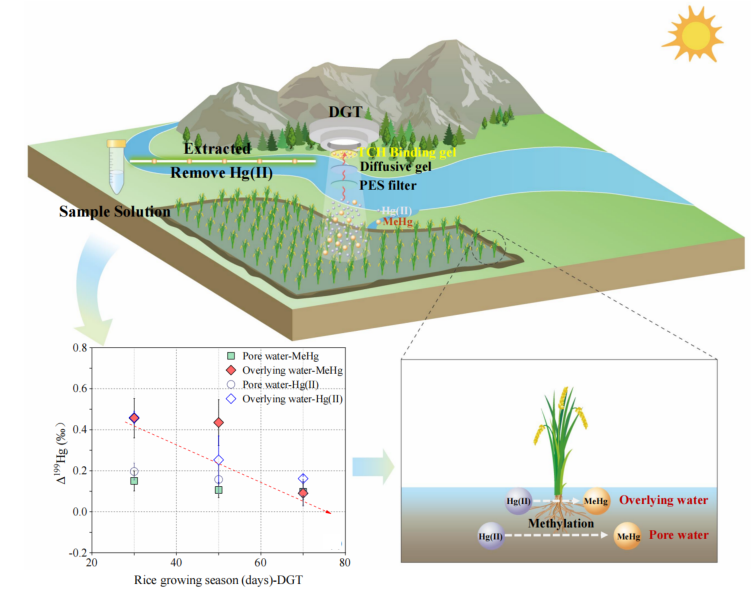The research team led by FENG Xinbin at the Institute of Geochemistry of the Chinese Academy of Sciences developed a novel DGT method for measuring the isotopic composition of aqueous methylmercury (MeHg) and successfully used it to accurately determine the isotopic compositions of MeHg in paddy water at Hg-contaminated sites.
Mercury (Hg) is a global pollutant. Its toxicity depends on its chemical form. Both inorganic and methylated Hg species pose health effects and ecological risks, but MeHg is particularly concerning due to its potent neurotoxicity, and ability to bioconcentrate and amplify along the food chain. Water bodies are often considered hotspots of MeHg production, yet scholars have persistently lacked a comprehensive understanding of its sources and transformation processes within aquatic environments.
Mercury isotopes are useful tracers to understand the sources and biogeochemical processes of Hg, which have been extensively applied to elucidate the transport and transformation processes of mercury in environmental matrices such as soils and atmosphere. Nevertheless, their application in aquatic environments remains severely constrained by analytical method. Particularly, precise measurement of MeHg isotopic composition in natural waters currently faces dual technical bottlenecks globally: first, the lack of efficient enrichment techniques for ultra-trace levels of MeHg; second, persistent interference from inorganic mercury in complex sample matrices. These twin technical challenges have led to a persistent lack of MeHg isotope data from natural waters, thereby constraining our understanding of MeHg sources and biogeochemical cycling in aquatic systems
In this study, researchers use diffusive gradients in thin films (DGT) in-situ to collect MeHg from paddy water to determine the concentration of MeHg and the associated isotopic composition. This technique enables high collection efficiency of aqueous MeHg with limited Hg isotope mass-dependent fractionation (~ −0.2‰ δ202Hg) and mass-independent fractionation (< 0.1‰ Δ199Hg). Field applications using the developed DGT method suggest that in-situ methylation of soluble Hg(II) drives the generation of MeHg in paddy water. MeHg in overlying water exhibits a Δ199Hg/Δ201Hg ratio of 1.07±0.09, indicating significant photoreduction of aqueous Hg(II) before methylation. The absence of photo-demethylation Δ199Hg/Δ201Hg ratio (~1.36) suggests limited MeHg demethylation in the overlying water.

Figure 1. Schematic illustration tracing sources and biogeochemical processes of MeHg in paddy waters using DGT technique(Image by IGCAS)
The study was published in the journal Analytical Chemistry on April 21.
This research not only fills a critical methodological gap in MeHg isotope analysis but also provides pivotal scientific foundations for elucidating the sources and transformation mechanisms of methylmercury in paddy waters (Figure 1). Ultimately, it offers crucial insight for mitigating MeHg contamination in rice and safeguarding food security.
Contact:
FENG Xinbin
Institute of Geochemistry, Chinese Academy of Sciences
Email: fengxinbin@vip.skleg.cn
(By Prof. FENG Xinbin’ s group)